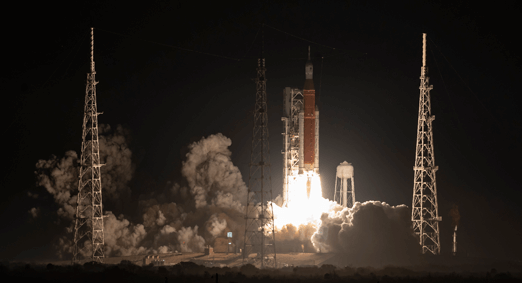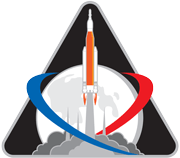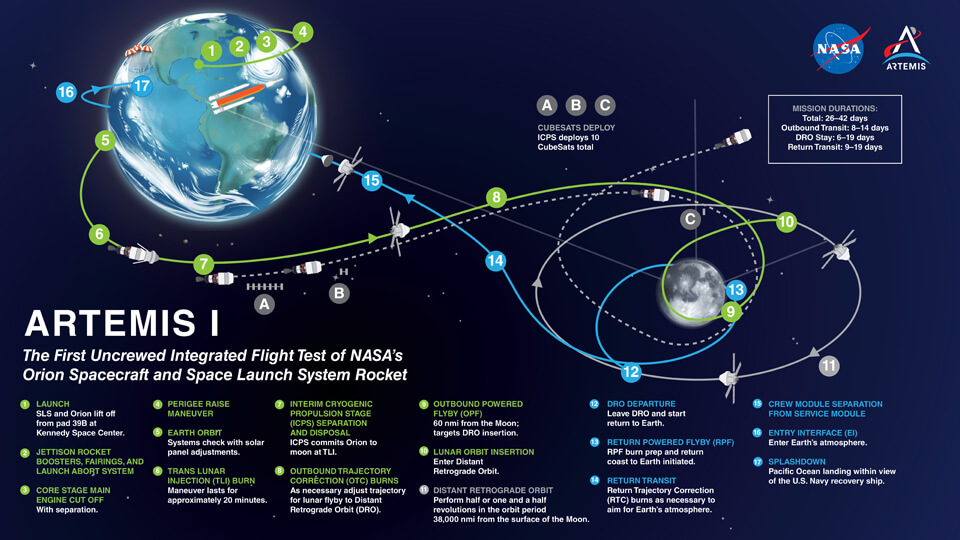Artemis-1 Lunar Mission
Artemis 1 launched on November 16 and returned to Earth on December 11, 2022


Artemis-1 was an uncrewed flight test to prove the systems that will take humans to the Moon. The first flight of SLS is also referred to as Exploration Mission-1 (EM-1). It was the first integrated test of NASA's Artemis space exploration system including the Orion spacecraft, the Space Launch System (SLS), the ground systems at the Kennedy Space Center, and other facilities.
The first date scheduled for launch was August 29, 2022, but it was scrubbed because Engine 3 was above the maximum allowable temperature limit for launch. The second launch attempt was scheduled for September but was scrubbed at 11:17 am EDT due to a fuel supply line leak in a service arm connecting to the engine section due to a hydrogen leak. Mission operators investigated whether an over-pressurization of the liquid line of the quick-disconnect interface during the launch attempt may have damaged a seal, allowing hydrogen to escape. Setbacks meant that NASA had to extend the certification of the flight termination system that is used to destroy a malfunctioning rocket at launch. Bad weather caused the SLS to be hauled back into the hangar. On September 26, the SLS rolled back out onto the launch pad. Bad weather once again delayed the launch.
Finally, the Space Launch System blasted off from LC-39B with the core stage carrying the Orion capsule into Earth orbit at 1:47 am EST on Wednesday, November 16, 2022. About 6 minutes later the main engine cut-off and the core stage dropped away. The Orion spacecraft deployed its solar arrays and the SLS's second stage the Interim Cryogenic Propulsion Stage (ICPS) fired, taking the capsule out of Earth’s orbit setting Orion on a Trans-Lunar Injection (TLI) orbit.
To continue toward the Moon, Orion was propelled by the European Space Agency's Service Module (ESM). The ESM has 3 types of engines - - Reaction Control System (RCS) thrusters for attitude control and small maneuvers and Auxiliary (Aux) engines for most maneuvers, and lastly, the Orbital Maneuvering System engine (OMS-E) for larger burns. The ESM provided Orion's propulsion system and power throughout the mission. The ESM has 3 types of engines - - Reaction Control System (RCS) thrusters for attitude control and small maneuvers and Auxiliary (Aux) engines for most maneuvers, and lastly, the Orbital Maneuvering System engine (OMS-E) for larger burns.
Orion passed through the Van Allen radiation belts and used NASA’s Tracking and Data Relay Satellite (TDRS) system to communicate with the Deep Space Network. The trip to the Moon took several days, while NASA engineers evaluated the spacecraft and assured it stayed on the proper course. The main engine on the ESM was tested, then Orion made a Distant Retrograde Orbit (DRO) around the Moon and back. This orbit took Orion one lap around the Moon over 12 days. This is a retrograde orbit (moving opposite from the Earth's orbit) about 40,000 miles (70,000 km) above the Moon's surface.
Next, Orion will make a close flyby within ~60 miles of the Moon’s surface. Another well-timed firing from the ESM will send Orion back toward Earth. The spacecraft will enter Earth’s atmosphere traveling at 25,000 mph enabling a second test of the important heat shield. The mission ends when Orion returns safely to the Earth off the coast of Baja, California. Orion will remain powered until it is recovered by ground teams from the waiting recovery ship.
To return to the Earth from orbit, the crew module will perform a skip entry technique, dipping into the upper part of Earth’s atmosphere and using the atmosphere and the lift of the space capsule to skip back out of the atmosphere, a bit like skipping a rock across water. The capsule then re-entered the atmosphere for final descent. The skip entry helped Orion to land closer to the coast of the United States.
The Crew Capsule used 11 parachutes to land. It first deploys three parachutes to help the parachute system to deploy properly (forward bay cover parachutes). Each of these are 7-feet in diameter and deployed at 26,500 feet in altitude when the vehicle is rushing at a speed of 475 feet per second or 324 mph. Next two drogue parachutes, 23-feet in diameter, are used to slow and stabilize the capsule during descent and prepare for the main parachute deployment. These are deployed at 25,000 feet in altitude when the vehicle's speed is 450 feet per second or 307 mph. Three Pilot parachutes, 11-feet in diameter, are used to lift and deploy the main parachutes from the crew module forward bay. These are deployed at 9,500 feet in altitude when the vehicle has slowed to the speed of 190 feet per second or 130 mph. Lastly, three Main parachutes that are used to slow the crew module for landing, to a speed that ensures astronaut safety. They are 116-feet in diameter and weigh 310 lbs. each. Main parachutes are deployed (lifted) from the crew module forward bay by the pilot parachutes. The Orion capsule is now able to splash down in the Pacific Ocean bringing the spacecraft safely home.


This image shows NASA's plan for Artemis I, provided by NASA, a high resolution image can be found at their website.

Callisto Technology Demonstration
Callisto is a collaboration between Lockheed Martin, Amazon, and Cisco. This team brought Alexa, the voice activated digital assistant and Webex, video collaboration tool to the Orion spacecraft, during the Artemis-1 mission. As humans continue to travel into space, this technology could help astronauts to operate more independently from Earth. For example, astronauts could ask a voice-activated device to talk them through a procedure.
Callisto used NASA’s Deep Space Network and a database aboard Orion to communicate with Alexa and receive a response from the device. This hardware has been hardened to protect it from the radiation environment on Orion’s journey outside Earth's protective magnetosphere. Webex will connect operators inside a room at Mission Control Center and Alexa, to hold a conference with the onboard tablet demonstrating how video collaboration can be used over the Deep Space Network.
The Orion spacecraft was uncrewed so the industry partners provided unique hardware to allow operators to interact with Callisto and evaluate its performance throughout the mission. Participants could ask Alexa a question or deliver a task command using a camera and microphone. Their images and voices were broadcast from mission control to Orion, where video of the participants was displayed on the tablet, and audio played from the speaker. Alexa will captured the audio and responded. At Lockheed Martin's Callisto site, anyone could leave a message or command for Alexa and the response was broadcast during a video session. Lockheed Martin presents some of the videos from the Artemis-1 mission.
- - Find out more at Lockheed Martin's Callisto website

Artemis-1 Rideshares
Sending Orion on its journey around the Moon was not the only mission SLS performed. On the Artemis-1 launch, SLS carried 13 small satellites to perform their own science and technology missions. These small satellites or "secondary payloads" were intended to help pave the way for future exploration missions to the Moon to Mars. It was a great opportunity for these small satellites to reach deep space destinations, because most of them were launched into low-Earth orbit. Unfortunately, multiple delays to launch Artemis-1 due to bad weather caused the CubeSats to lose battery power and many were lost. Other CubeSats were able to carry out their missions. Status of the missions are given as of May 24, 2023
Artemis-1 Successful CubSats
BioSentinel
BioSentinel uses yeast to detect, measure the impact of deep space radiation on living organisms over long durations in deep space. The BioSentinel biosensor utilizes the yeast Saccharomyces cerevisiae to study the effects of space radiation. It was the only biological investigation flown on Artemis-1. BioSentinel is 6 months into its 18-month mission.
Argo Moon
Argo Moon was developed by Italian Space Agency (ASI) and the European Space Agency (ESA). ArgoMoon proved that it could function close to the Interim Cryogenic Propulsion Stage (ICPS). It was intended to monitor the deployment of the CubeSats from the ICPS because it was unable to give the status of the satellites while it was carrying out their release. Argo Moon documented the ICPS in action and provided data that might prove useful for planning future deep space missions. Argo Moon captured two images - - planet Earth from 125,000 km and the Moon at 278,500 km. It will continue to operate, sending signals back to Earth until its orbit decays.
EQUilibriUm Lunar-Earth point 6U Spacecraft (EQUULEUS)
EQUULEUS was developed by the Japan Aerospace Exploration Agency (JAXA) and the University of Toyoko's Intelligent Space Systems Laboratory. It measures the amount of plasma that surrounds the Earth (plasmasphere) to increase understanding of the radiation environment in that region. Mapping the plasmasphere may provide important insights to protecting humans and electronics from radiation during long space journeys.
EQUULEUS will also demonstrate low-thrust trajectory control techniques making multiple lunar flybys within the Earth-Moon Lagrange (EML) points. The mission will demonstrate that spacecraft departing from EML can transfer to various orbits - - Earth orbits, Moon orbits, and interplanetary orbits, using a minimum of orbital control. EQUULEUS has passed its primary six-month mission and is still at work.
The mission is monitored by the Japanese deep space antennae (64-meter and 34-meter antenna) with support from NASA’s Deep Space Network. The principal investigator is Professor Hashimoto at JAXA. The mission is named after the "little horse" constellation Equuleus. Its propulsion system is called AQUARIUS as it uses eight water thrusters for attitude control. Its water tank must be kept over 0°C at all times to keep the water from freezing. Some of EQUULEUS's instruments are named after the constellations that are near Equuleus in the sky.
EQUULEUS Science Instruments
Plasmaspheric Helium ion Observation by Enhanced New Imager in eXtreme ultraviolet (PHOENIX)
PHOENIX is a small imager working in the high-energy extreme ultraviolet wavelengths. It has a 60-mm diameter mirror and a photon counting device. The mirror is designed to detect helium ions, an important component of Earth's plasmasphere. The plasmasphere is a region of space around Earth where electrically charged particles (ions) are trapped by the Earth's magnetic field. The ions are caused by ultraviolet radiation from the Sun. When flying far from the Earth, the PHOENIX telescope will provide a global image of the plasmasphere.
DEtection camera for Lunar impact PHenomena IN 6U Spacecraft (DELPHINUS)
DELPHINUS or DLP, is a camera connected to the PHOENIX telescope to observe lunar impact flashes and near-Earth asteroids (NEO), and "mini-moons", that are NEOs temporarily captured at the Earth-Moon Lagrangian point L2. (For example - 2006 RH120). If a mini-moon or NEO that can be studied by EQUULEUS is identified, the CubeSat can attempt to flyby. This can help with risk evaluation for future lunar missions.
Cis-Lunar Object Detector within Thermal Insulation (CLOTH)
CLOTH is a dust detector located in the multi-layered thermal insulator (MLI) of the CubeSat, the outer protection of the spacecraft. It observes the micrometeoroids in the cislunar space using dust detectors mounted on the exterior of the spacecraft. It is the first instrument to measure the dust environment of the Earth–Moon L2 Lagrange point. It is intended to discover the dust's origin and help with risk assessment of the L2 point dust particles for future crewed missions.
NASA’s Cube Quest Challenge
Team Miles won the first place at CubeQuest Challenge. It is a CubeSat mission built to demonstrate navigation in deep space using plasma thrusters and test a software-defined radio operating in the S-band for communications. The thruster called, ConstantQ Model H was invented by Wesley Faler. The CubeSat has been operating for over 6 months since deployment.
Less Successful CubeSats
CubeSat for Solar Particles (CuSP) was a "space weather station" to measure particles and magnetic fields in space. It was intended to test the practicality for a network of stations to monitor space weather. Unfortunately, although initial communications were established with the CubeSat, the mission was unsuccessful. NASA will attempt to contact the CubeSat in the 3rd quarter of 2023.
Lunar Flashlight was developed by NASA's Jet Propulsion Laboratory to look for ice deposits and identify locations with accessible resources. Lunar Flashlight was to be the first mission to look for water ice using a laser reflectometer and the first planetary CubeSat mission to use "green" propulsion, that is, a propellant that is less toxic and safer than hydrazine often used by spacecraft. Not launched on the Artemis-1 flight, Lunar Flashlight unfortunately has been canceled by NASA.
Near-Earth Asteroid Scout (NEA), or NEA Scout was intended to perform reconnaissance of an asteroid, take pictures and observe its position in space. NEA Scout was to be propelled by a solar sail. NEA Scout's target asteroid was the asteroid 2020 GE. NEA Scout was launched into a heliocentric orbit from the Space Launch System on Artemis 1 on November 16, 2022. Unfortunately communications with the CubeSat were never established.
Outstanding MOon exploration TEchnologies demonstrated by NAno Semi-Hard Impactor (OMOTENASH)
OMOTENASHI was a CubeSat intended to demonstrate low-cost technology to land and explore the lunar surface. "Omotenashi" is a Japanese word for "welcome" or "hospitality". Unfortunately, the mission was unsuccessful.
Next Space Technologies for Exploration Partnerships (NextSTEP)
Lunar IceCube developed by Morehead State University, in Kentucky, built a CubeSat to search for water ice and other resources. It was to fly a low orbit of only 62 miles (~100 km) above the surface of the moon. The spacecraft was not able to align its solar panels to the Sun.
Skyfire aka LunIR was a technology demonstration CubeSat developed by Lockheed Martin Space Systems Company. The CubeSat was to make a lunar flyby of the moon, collecting data during the flyby to improve our knowledge of the lunar surface and survey landing sites. Unfortunately it was unsuccessful.
NASA’s Cube Quest Challenge
CU-E3 from the University of Colorado Boulder. CU-E3 intended to use a lunar gravity assist to propel itself into heliocentric orbit that would increase the distance between itself and the Earth. The CubeSat would attempt to establish contact with its ground station network once it moves beyond 4-million km away and continue until the end of its one-year mission lifetime when it would be more than 10-million km away from Earth! The CubeSat was not ready in time to launch with Artemis-1.
Cislunar Explorers from Cornell University, was not ready in time for the flight.

NASA released the video embedded here to explain the Artemis-1 mission. It lasts about 5 minutes and is a nice overview.

Artemis-1 Green Run Tests
NASA's Green Run tests was a step-by-step testing program for the new SLS rocket core that will be used to launch astronauts to the Moon. The tests were made through a collaboration between the SLS program, the Stennis test team, Boeing and Aerojet Rocketdyne. They were conducted using the B-2 Test Stand that was previously used to test the Saturn V rocket, and later the RS-25 engines for Space Shuttle.
The Green Run tests began in January 2020 and the first 6 were completed by October but the last 2 tests were delayed by hurricanes. Engineers loaded more than 700,000 pounds of cryogenic propellants and drained the SLS tanks again on December 20, 2020. On March 18, 2021, SLS passed NASA Green Run text 8, successfully firing all four RS-25 engines for 8 minutes and 20 seconds. When the tests were successfully completed, SLS was sent to the Kennedy Space Center. The last test was a wet dress rehearsal, and it was the final test needed before Artemis-1 can launch. On June 20, 2022, NASA tested the system, loading propellant into the rocket’s tanks, conducting a full launch countdown, recycling the countdown clock, and finally draining the tanks. This last test was declared successful and the system was declared ready for launch.
